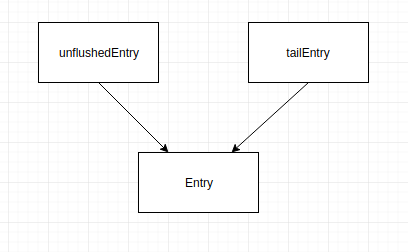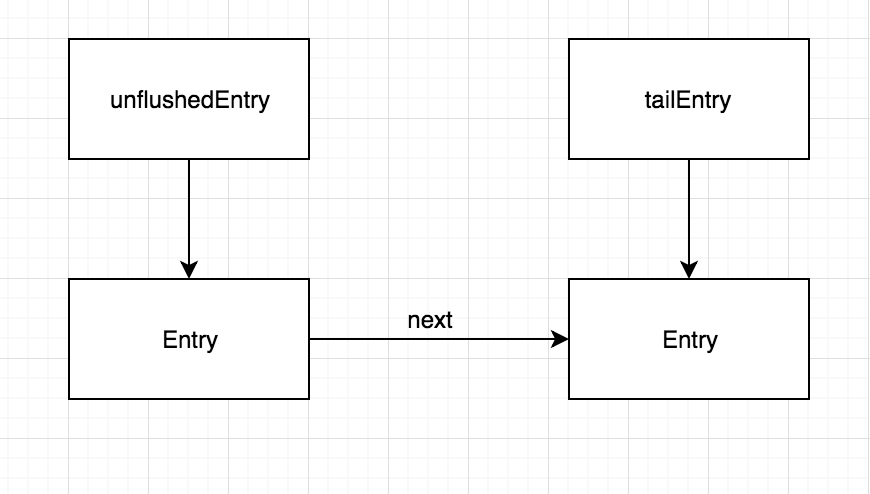Netty源码分析-8-ChannelOutboundBuffer
前面我们看到了Java对象如何通过Encoder转换成ByteBuf对象的,那么现在问题来了,ByteBuf是如何写入到远程节点的呢,这就是本文要分析的内容。
在前面的ChannelPipeline分析中我们提到过HeadContext和TailContext两个特殊的ChannelHandlerContexty,而HeadContext就是位于最前方的ChannelOutboundHandler,它也是最终负责处理write、flush等outbound事件的处理器。
从HeadContext的write和flush方法实现可以看到,其委托给了所在channelPipeline的channel的unsafe来实现。
final class HeadContextextends AbstractChannelHandlerContext
implementsChannelOutboundHandler,ChannelInboundHandler{
private final Unsafe unsafe;
HeadContext(DefaultChannelPipeline pipeline) {
super(pipeline, null, HEAD_NAME, false, true);
unsafe = pipeline.channel().unsafe();
setAddComplete();
}
...
@Override
public void write(ChannelHandlerContext ctx, Object msg, ChannelPromise promise) throws Exception {
unsafe.write(msg, promise);
}
@Override
public void flush(ChannelHandlerContext ctx) throws Exception {
unsafe.flush();
}
AbstractNioChannel使用的AbstractNioUnsafe和AbstractUnsafe差别不大。我们注重看一下AbstractUnsafe类。首先这里声明了一个ChannelOutboundBuffer类,这个类是用来保存已经write的ByteBuf但是还没有flush的ByteBuf以及已经flush但是还没有写到远端的数据。
protected abstract class AbstractUnsafeimplements Unsafe{
private volatile ChannelOutboundBuffer outboundBuffer = new ChannelOutboundBuffer(AbstractChannel.this);
private RecvByteBufAllocator.Handle recvHandle;
private boolean inFlush0;
ChannelOutboundBuffer由一个链表构成,链表的Entry中保存表示的消息、next指针等。
其中几个比较关键的变量
- flushedEntry表示从这个节点一直到unflushedEntry前的节点都是被标记为flushed的,但是还没有写入到channel中的
- unflushedEntry标记哪个节点开始还没有被flush
- tailEntry表示链表的最后一个元素
- flushed表示已经flush但是还没有write的Entry的数量
public final class ChannelOutboundBuffer{ private final Channel channel; // Entry(flushedEntry) --> ... Entry(unflushedEntry) --> ... Entry(tailEntry) // // The Entry that is the first in the linked-list structure that was flushed private Entry flushedEntry; // The Entry which is the first unflushed in the linked-list structure private Entry unflushedEntry; // The Entry which represents the tail of the buffer private Entry tailEntry; // The number of flushed entries that are not written yet private int flushed; ...
addMessage
再来看下AbstractUnsafe的write实现,最关键的地方是调用outboundBuffer.addMessage(msg, size, promise),这样将write的消息放到了outboundBuffer链表中。
@Override
public final void write(Object msg, ChannelPromise promise) {
assertEventLoop();
ChannelOutboundBuffer outboundBuffer = this.outboundBuffer;
if (outboundBuffer == null) {
// If the outboundBuffer is null we know the channel was closed and so
// need to fail the future right away. If it is not null the handling of the rest
// will be done in flush0()
// See https://github.com/netty/netty/issues/2362
safeSetFailure(promise, WRITE_CLOSED_CHANNEL_EXCEPTION);
// release message now to prevent resource-leak
ReferenceCountUtil.release(msg);
return;
}
int size;
try {
msg = filterOutboundMessage(msg);
size = pipeline.estimatorHandle().size(msg);
if (size < 0) {
size = 0;
}
} catch (Throwable t) {
safeSetFailure(promise, t);
ReferenceCountUtil.release(msg);
return;
}
outboundBuffer.addMessage(msg, size, promise);
}
如果当前channel的outbound没有创建或之前的都已经write完成,则会是下图所示状态。这个Entry本身是unflushedEntry和tailEntry

再加一个消息Entry后

应用层调用完write后不一定会立即进行flush,flush会进行系统调用是一个相对耗时的操作,所以有些优化会在channelReadComplete时来进行flush。
flush
flush分为两步
- 调用outboundBuffer.addFlush,设置flushedEntry,标识flushedEntry及之前的Entry都可以真正写入channel了
- 调用flush0,进行真正写入到channel里,这里有的实现会进行选择性的是否flush到channel,例如AbstractNioChannel里的AbstractNioUnsafe实现为现在是否在等待flush,如果等待状态则说明一定会flush,这里就不需要再调用了
@Override public final void flush(){ assertEventLoop(); ChannelOutboundBuffer outboundBuffer = this.outboundBuffer; if (outboundBuffer == null) { return; } outboundBuffer.addFlush(); flush0(); }
addFlush
addFlush会从unflushedEntry开始,如果之前flushedEntry指向空,则将flushEntry指向unflushedEntry,然后开始遍历到tailEntry并且记录flushed数量
最后将unflushedEntry设置为null
如果这个时候又调用了addMessage,则此时的结构是这样的
flushedEntry –> entry –> entry –> unflushedEntry –> entry –> tailEntry

public void addFlush(){
// There is no need to process all entries if there was already a flush before and no new messages
// where added in the meantime.
//
// See https://github.com/netty/netty/issues/2577
Entry entry = unflushedEntry;
if (entry != null) {
if (flushedEntry == null) {
// there is no flushedEntry yet, so start with the entry
flushedEntry = entry;
}
do {
flushed ++;
if (!entry.promise.setUncancellable()) {
// Was cancelled so make sure we free up memory and notify about the freed bytes
int pending = entry.cancel();
decrementPendingOutboundBytes(pending, false, true);
}
entry = entry.next;
} while (entry != null);
// All flushed so reset unflushedEntry
unflushedEntry = null;
}
}
- flush0中首先判断当前channel是否已经在flush了,如果是则跳过,否则设置inFlush0状态并继续
- 做一些辅助判断,然后调用doWrite(outboundBuffer)
@SuppressWarnings("deprecation") protected void flush0() { if (inFlush0) { // Avoid re-entrance return; } final ChannelOutboundBuffer outboundBuffer = this.outboundBuffer; if (outboundBuffer == null || outboundBuffer.isEmpty()) { return; } inFlush0 = true; // Mark all pending write requests as failure if the channel is inactive. if (!isActive()) { try { if (isOpen()) { outboundBuffer.failFlushed(FLUSH0_NOT_YET_CONNECTED_EXCEPTION, true); } else { // Do not trigger channelWritabilityChanged because the channel is closed already. outboundBuffer.failFlushed(FLUSH0_CLOSED_CHANNEL_EXCEPTION, false); } } finally { inFlush0 = false; } return; } try { doWrite(outboundBuffer); } catch (Throwable t) { if (t instanceof IOException && config().isAutoClose()) { /** * Just call {@link#close(ChannelPromise, Throwable, boolean)} here which will take care of * failing all flushed messages and also ensure the actual close of the underlying transport * will happen before the promises are notified. * * This is needed as otherwise {@link#isActive()} , {@link#isOpen()} and {@link#isWritable()} * may still return {@codetrue} even if the channel should be closed as result of the exception. */ close(voidPromise(), t, FLUSH0_CLOSED_CHANNEL_EXCEPTION, false); } else { try { shutdownOutput(voidPromise(), t); } catch (Throwable t2) { close(voidPromise(), t2, FLUSH0_CLOSED_CHANNEL_EXCEPTION, false); } } } finally { inFlush0 = false; } }
NioSocketChannel.doWrite
doWrite方法是抽象的,需要各个AbstractChannel的具体类实现的。
NioSocketChannel实现如下
- 获取到真正的jdk的SocketChannel
- 在一个循环执行
- 如果没有可写的数据了,清除selectionKey的OP_WRITE并返回
- 取出ChannelOutboundBuffer中的ByteBuffer数组,调用SocketChannel.write方法写入到channel。
- 如果写入数量小于等于0,设置SelectionKey的OP_WRITE
- 否则调用ChannelOutboundBuffer方法
protected void doWrite(ChannelOutboundBuffer in) throws Exception { SocketChannel ch = javaChannel(); int writeSpinCount = config().getWriteSpinCount(); do { if (in.isEmpty()) { // All written so clear OP_WRITE clearOpWrite(); // Directly return here so incompleteWrite(...) is not called. return; } // Ensure the pending writes are made of ByteBufs only. int maxBytesPerGatheringWrite = ((NioSocketChannelConfig) config).getMaxBytesPerGatheringWrite(); ByteBuffer[] nioBuffers = in.nioBuffers(1024, maxBytesPerGatheringWrite); int nioBufferCnt = in.nioBufferCount(); // Always us nioBuffers() to workaround data-corruption. // See https://github.com/netty/netty/issues/2761 switch (nioBufferCnt) { case 0: // We have something else beside ByteBuffers to write so fallback to normal writes. writeSpinCount -= doWrite0(in); break; case 1: { // Only one ByteBuf so use non-gathering write // Zero length buffers are not added to nioBuffers by ChannelOutboundBuffer, so there is no need // to check if the total size of all the buffers is non-zero. ByteBuffer buffer = nioBuffers[0]; int attemptedBytes = buffer.remaining(); final int localWrittenBytes = ch.write(buffer); if (localWrittenBytes <= 0) { incompleteWrite(true); return; } adjustMaxBytesPerGatheringWrite(attemptedBytes, localWrittenBytes, maxBytesPerGatheringWrite); in.removeBytes(localWrittenBytes); --writeSpinCount; break; } default: { // Zero length buffers are not added to nioBuffers by ChannelOutboundBuffer, so there is no need // to check if the total size of all the buffers is non-zero. // We limit the max amount to int above so cast is safe long attemptedBytes = in.nioBufferSize(); final long localWrittenBytes = ch.write(nioBuffers, 0, nioBufferCnt); if (localWrittenBytes <= 0) { incompleteWrite(true); return; } // Casting to int is safe because we limit the total amount of data in the nioBuffers to int above. adjustMaxBytesPerGatheringWrite((int) attemptedBytes, (int) localWrittenBytes, maxBytesPerGatheringWrite); in.removeBytes(localWrittenBytes); --writeSpinCount; break; } } } while (writeSpinCount > 0); incompleteWrite(writeSpinCount < 0); }
ChannelOutboundBuffer.removeBytes
removeBytes负责从ChannelOutboundBuffer中的链表中删除已经真正写入完成的Entry
- 获取flushedEntry,判断当前Entry的ByteBuf中可读数量如果小于了writtenBytes,说明已经写入了不止当前Entry数据,则调用remove删除当前Entry
- 否则则移动当前Entry的ByteBuf的readerIndex
- 将nioBuffer数组元素均设置为null
public void removeBytes(long writtenBytes){ for (;;) { Object msg = current(); if (!(msg instanceof ByteBuf)) { assert writtenBytes == 0; break; } final ByteBuf buf = (ByteBuf) msg; final int readerIndex = buf.readerIndex(); final int readableBytes = buf.writerIndex() - readerIndex; if (readableBytes <= writtenBytes) { if (writtenBytes != 0) { progress(readableBytes); writtenBytes -= readableBytes; } remove(); } else { // readableBytes > writtenBytes if (writtenBytes != 0) { buf.readerIndex(readerIndex + (int) writtenBytes); progress(writtenBytes); } break; } } clearNioBuffers(); }
public boolean remove() {
Entry e = flushedEntry;
if (e == null) {
clearNioBuffers();
return false;
}
Object msg = e.msg;
ChannelPromise promise = e.promise;
int size = e.pendingSize;
removeEntry(e);
if (!e.cancelled) {
// only release message, notify and decrement if it was not canceled before.
ReferenceCountUtil.safeRelease(msg);
safeSuccess(promise);
decrementPendingOutboundBytes(size, false, true);
}
// recycle the entry
e.recycle();
return true;
}
removeEntry判断当前flushed的Entry是否已经删除完了,如果删完了则设置flushedEntry为null并且如果已经删到了tailEntry
则把tailEntry和unflushedEntry也设置为null
否则将flushedEntry指向移到next
private void removeEntry(Entry e) {
if (-- flushed == 0) {
// processed everything
flushedEntry = null;
if (e == tailEntry) {
tailEntry = null;
unflushedEntry = null;
}
} else {
flushedEntry = e.next;
}
}
至此,一个应用中的数据如何通过Encoder转换成ByteBuf,存储到ChannelOutboundBuffer,然后写入到SocketChannel中的过程已经清晰了。











![[HBLOG]公众号](https://www.liuhaihua.cn/img/qrcode_gzh.jpg)

